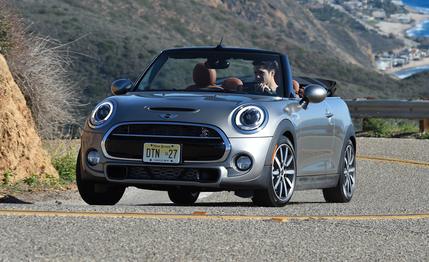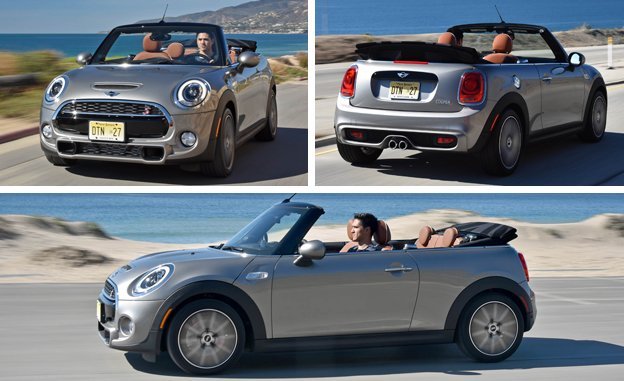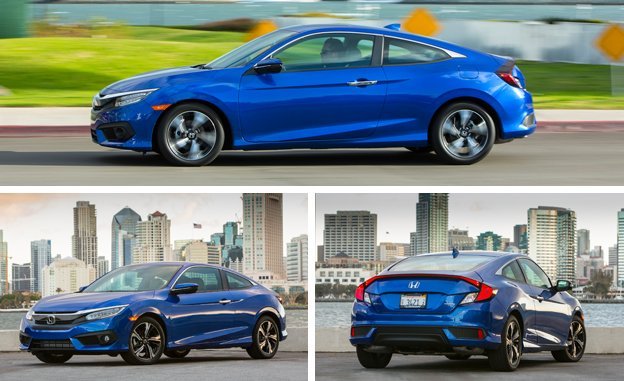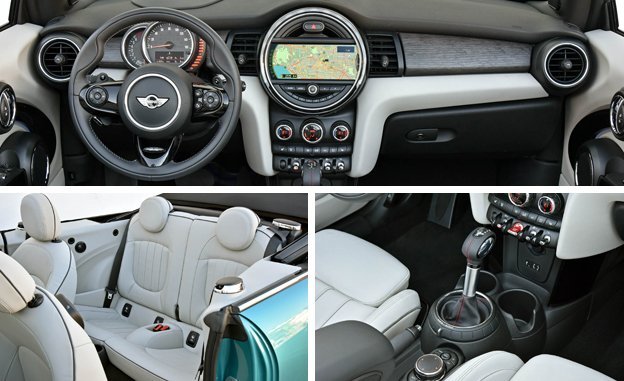
 First Drive Review
First Drive Review
The Mini Cooper is not a serious car. In fact, it’s rather determinedly lighthearted, what with its puppy-dog styling, candy-dish colors, and cheeky marketing. And since convertibles in general are inherently unserious, given their priorities of wind in the hair and suntanning, the intersection of Mini and convertible is guaranteed to be rather silly.
It’s been that way since the new-generation Mini added a convertible variant for 2005. The follow up to that car introduced the Always Open Timer (a.k.a. Openometer)—essentially an odometer that tallies top-down time—and the feature returns to track that all-important metric. This generation’s new frivolity is an available softtop that sports a giant Union Jack graphic. Oh, and the Mini Connected app includes a new function: It can send an alert of an approaching rain shower, so the driver can raise the top. If the car has been parked with the roof down, the alert comes to the driver’s smartphone (if the car was parked with the top up, no alert is sent); if the car is being driven with the top down, the alert appears on the center screen.


Speaking of putting the top up, that process takes 18 seconds and can be performed at speeds up to 18 mph. (Both numbers also apply to lowering it.) The choreography is entirely automated and can even be initiated via a button on the remote. As in previous Mini convertibles, the front portion retracts like a sunroof if you don’t feel like going fully alfresco. Lowered, the top stack cuts into rear visibility, although in parking maneuvers, the backup camera—a $500 must-have—does compensate.
Outside of its convertible top, the new Mini convertible parallels all the changes that have come to the third-generation Mini Hardtop and the redesigned Clubman: It’s considerably larger, it features new three- and four-cylinder turbocharged engines, and it boasts lots more tech features, including adaptive cruise control with forward-collision warning, pedestrian detection, and automatic braking.
The now-familiar powertrains consist of a 134-hp 1.5-liter three-cylinder turbo for the base Cooper, while the S packs a 189-hp 2.0-liter turbo four. The John Cooper Works model (which is being launched almost simultaneously) gets the turbo four in 228-hp strength. All offer a choice of a six-speed automatic or, commendably, a six-speed stick.


Our drive was limited to the Cooper S, although we sampled both transmissions. As in the Hardtop, the S feels fairly quick—Mini estimates zero-to-60-mph times of 6.7 seconds for the automatic with the manual 0.1 second behind—although booting the throttle at lower speeds brings a tug of torque steer. The automatic is not only fractionally quicker, it’s also more economical, at 25 mpg in the city and 34 on the highway versus 23/33 mpg for the manual. The automatic is pretty adept at choosing ratios but the stick is still our preference, particularly given the Mini’s friendly clutch and easy shift action. DIY shifting also saves a chunk of change, as the automatic is $1250 sans shift paddles or $1500 with (S only).
Mini notes that the convertible receives structural bracing in the rocker panels and a stiffening plate under the engine, as well as torsional reinforcement struts. Nonetheless, we detected some cowl quiver as we rolled down the mean streets of downtown Los Angeles. Our test car was equipped with the optional Dynamic Damper Control, which allowed us to switch the dampers between Normal and Sport modes. Although Mini has earned a reputation for a harsh ride, in Normal mode the convertible actually is not bad in that regard. Once out of the city and into the Hollywood hills and the canyons above Malibu, however, we definitely preferred the Sport mode’s firmer body control, which helps this larger, heavier Mini better live up to the brand’s promise of lively cornering.


While the faraway-seeming windshield can make looking out of the Mini Hardtop seem like peering through goggles, in the convertible—with the roof down, at least—it’s a plus, as it emphasizes the experience of having nothing but sky above. Our richly equipped test cars effectively banished the cheapness of previous-generation Mini interiors. (The $1750 Chesterfield leather is particularly nice; Malt Brown is a convertible-only color.) The new, more-conventional gauge layout features the speedometer in front of the driver, but there’s also an available head-up display that projects info onto a plastic screen atop the dash. The front seats, which boast a greater range of adjustment than before, are fine for drivers of nearly all sizes, but the convertible’s four-seat designation is still pretty theoretical despite an additional 1.6 inches of rear legroom and 0.5-inch more shoulder room. When the front seat is adjusted for an average-size adult, the seatback almost touches the rear-seat cushion. There’s precious little space to wedge one’s sneakers between the front seatback and the rear-seat cushion, and back-seat riders sit bolt upright, which isn’t exactly our idea of fun. The rear bench does make a fine place to toss your stuff, however, provided you don’t want to use the now-larger trunk, which also comes with a standard pass-through.
With the demise of the two-seat Roadster—which along with its sibling Coupe model proved too ridiculous even for Mini—the convertible will stand as the sole offering for sun-seeking Mini buyers. This model’s frivolity, however, does not extend to its price. The standard tariffs of $26,800 for the Cooper and $30,450 for the S are reasonable, but as is typical with the third-generation Mini, option prices add up quickly. The two Cooper S convertibles we drove rang in at a hair under $40,000—not all that frivolous, really.